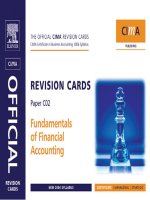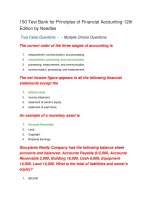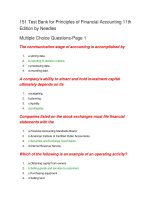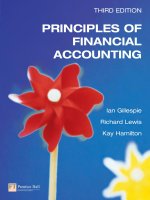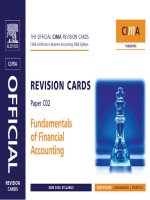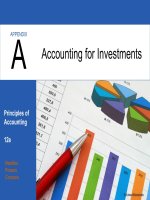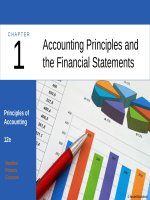Principles of financial accounting 12e by needles crosson chapter 20
Bạn đang xem bản rút gọn của tài liệu. Xem và tải ngay bản đầy đủ của tài liệu tại đây (348.15 KB, 24 trang )
CHAPTER
20
Value-Based Systems:
Activity-Based Costing and
Lean Accounting
Principles of
Accounting
12e
Needles
Powers
Crosson
©human/iStockphoto
Concepts Underlying Value-Based Systems
Value -bas e d s ys te ms provide customerrelated, activity-based information.
– They focus on eliminating waste as companies
produce and deliver quality products and services.
– Managers can use value-based information
reliably to compare the value created by products
or services with the full pro duc t c o s t, which
includes not only the costs of direct materials and
direct labor, but also the costs of all production
and nonproduction activities required to satisfy
the customer.
©2014 Cengage Learning. All Rights Reserved. May not be scanned, copied or duplicated, or posted to a publicly accessible website, in whole or in part.
Value Chain Analysis
Each step in making a product or delivering a
service is a link in a chain that adds value to
the product or service. This sequence of
activities inside the organization that adds
value to a company’s product or service is
known as the value c hain.
– The steps that add value to a product or service—
which range from research and development to
customer service—are known as primary
pro c e s s e s .
©2014 Cengage Learning. All Rights Reserved. May not be scanned, copiedr or duplicated, or posted to a publicly accessible website, in whole or in part.
Value Chain Analysis
– The value chain also includes s uppo rt s e rvic e s ,
such as legal services, human resources,
information technology, and accounting, which
facilitate the primary processes by providing
business infrastructure but do not add value to the
final product or service.
– Value chain analysis allows a company to focus on
its core competencies. A c o re c o mpe te nc y is the
activity that a company does best and that gives it an
advantage over its competitors.
A common result of value chain analysis is outsourcing.
Outs o urc ing is engagement of other companies to perform
a process or service in the value chain that is not among an
organization’s core competencies.
©2014 Cengage Learning. All Rights Reserved. May not be scanned, copied or duplicated, or posted to a publicly accessible website, in whole or in part.
Supply Chains
Managers see their organization’s internal
value chain as part of a larger system. This
larger system is the s upply c hain (or the
s upply ne twork)—the path that leads from
the suppliers of the materials from which a
product is made to the final customer.
– The supply chain includes both suppliers and
suppliers’ suppliers, and customers and
customers’ customers.
– Each organization in the supply chain is a
customer of an earlier supplier, and each has its
own value chain.
©2014 Cengage Learning. All Rights Reserved. May not be scanned, copied or duplicated, or posted to a publicly accessible website, in whole or in part.
Process Value Analysis
Managers use pro c e s s value analys is (PVA) to
identify and link all the activities involved in the value
chain.
– A value -adding ac tivity is one that adds value to a product
or service as perceived by the customer. In other words, if
customers are willing to pay for the activity, it adds value to
the product or service.
– A no n-value -adding ac tivity is one that adds cost to a
product or service but does not increase its market value.
Managers eliminate non-value-adding activities that are not
essential and reduce the costs of those that are, such as legal
services, management accounting, machine repair, materials
handling, and building maintenance.
©2014 Cengage Learning. All Rights Reserved. May not be scanned, copied or duplicated, or posted to a publicly accessible website, in whole or in part.
Activity-Based Management
Ac tivity-bas e d manag e me nt (ABM) identifies all
major operating activities, determines the resources
consumed by each activity and the cause of the
resource usage, and categorizes the activities as
adding value to a product or service or not adding
value.
– ABM focuses on reducing or eliminating non-value-adding
activities. It helps managers eliminate waste and redirect
resources to activities that add value to the product or
service.
– Ac tivity-bas e d c o s ting (ABC) is the tool used in an ABM
environment to assign activity costs to cost objects.
It categorizes all indirect costs by activity, traces the indirect
costs to those activities, and assigns those costs to products or
services using a cost driver related to the cause of the cost.
©2014 Cengage Learning. All Rights Reserved. May not be scanned, copied or duplicated, or posted to a publicly accessible website, in whole or in part.
Cost Hierarchy
A c o s t hie rarc hy is a framework for
classifying activities according to the level at
which their costs are incurred.
– In a manufacturing company, the cost hierarchy
typically has four levels.
Unit-le ve l ac tivitie s are performed each time a unit is
produced and are generally considered variable costs.
Batc h-le ve l ac tivitie s are performed each time a batch
or production run of goods is produced.
Pro duc t-le ve l ac tivitie s are performed to support a
particular product line.
Fac ility-le ve l ac tivitie s are performed to support a
facility’s general manufacturing process and are
generally fixed costs.
©2014 Cengage Learning. All Rights Reserved. May not be scanned, copied or duplicated, or posted to a publicly accessible website, in whole or in part.
Bill of Activities
A bill o f ac tivitie s is a list of activities and
related costs that is used to compute the
costs assigned to activities and the product
unit cost.
©2014 Cengage Learning. All Rights Reserved. May not be scanned, copied or duplicated, or posted to a publicly accessible website, in whole or in part.
The New Operating Environment and
Lean Operations
A le an o pe ratio n focuses on eliminating waste in an
organization and on what a customer is willing to pay
for.
– To achieve lean operations, a company must redesign its
operating systems, plant layout, and basic management
methods to conform to several basic concepts that
emphasize simplicity, quality, continuous improvement,
minimum inventories, multiskilled workers, and eliminating
waste and non-value-adding activities.
– Piecemeal attempts at lean operations have proved
disastrous when the implementation focused on a few lean
tools and methodologies instead of understanding how to
think lean throughout the organization.
©2014 Cengage Learning. All Rights Reserved. May not be scanned, copied or duplicated, or posted to a publicly accessible website, in whole or in part.
Just-in-Time (JIT)
In a lean operation, the jus t-in-time (JIT)
o pe rating philo s o phy requires that all
resources—materials, personnel, and
facilities—be acquired and used only as
needed to create value for customers.
©2014 Cengage Learning. All Rights Reserved. May not be scanned, copied or duplicated, or posted to a publicly accessible website, in whole or in part.
Minimum Inventory Levels
In a J IT environment, materials and parts are
purchased and received only when they are
needed.
– The J IT approach lowers costs by reducing the
space needed for inventory storage, the amount
of materials handling, and the amount of inventory
obsolescence.
– It reduces the need for inventory control facilities,
personnel, and recordkeeping.
– It significantly decreases the amount of work in
process inventory and the amount of working
capital tied up in all inventories.
©2014 Cengage Learning. All Rights Reserved. May not be scanned, copied or duplicated, or posted to a publicly accessible website, in whole or in part.
Pull-Through Production
In pull-thro ug h pro duc tio n, a customer’s
order triggers the purchase of materials and
the scheduling of production for the products
that have been order.
– In contrast, with the pus h-thro ug h pro duc tio n
method used in traditional manufacturing
operations, products are manufactured in long
production runs and stored in anticipation of
customers’ orders.
– With pull-through production, the size of a
customer’s order determines the size of a
production run, and the company purchases
materials and parts as needed.
©2014 Cengage Learning. All Rights Reserved. May not be scanned, copied or duplicated, or posted to a publicly accessible website, in whole or in part.
Quick Setup and Flexible Work Cells
By placing machines in more efficient
locations and standardizing setups, setup
time can be minimized in a J IT environment.
– By changing the factory layout so that all the
machines needed for sequential processing are
placed together, J IT may cut the manufacturing
time significantly.
– The new cluster of machinery forms a flexible
wo rk c e ll, an autonomous production line that
can perform all required operations efficiently and
continuously.
– The more flexible the work cell is, the greater its
potential to minimize total production time.
©2014 Cengage Learning. All Rights Reserved. May not be scanned, copied or duplicated, or posted to a publicly accessible website, in whole or in part.
A Multiskilled Workforce
In flexible work cells, one worker may be
required to operate several types of
machines simultaneously.
– The worker may have to set up and retool the
machines and even perform routine maintenance
on them.
– Under a J IT operating philosophy, multiskilled
workers have been very effective in contributing
to high levels of productivity.
©2014 Cengage Learning. All Rights Reserved. May not be scanned, copied or duplicated, or posted to a publicly accessible website, in whole or in part.
High Levels of Product Quality
A J IT environment results in high-quality
products, since high-quality direct materials
are used and inspections are made
throughout the production process.
– In a J IT environment, inspection as a separate
step does not add value to a product, so
inspection is incorporated into ongoing
operations.
– A J IT machine operator inspects the products as
they pass through the manufacturing process
and, if he or she detects a flaw, shuts down the
work cell until the problem can be determined and
corrected.
©2014 Cengage Learning. All Rights Reserved. May not be scanned, copied or duplicated, or posted to a publicly accessible website, in whole or in part.
Effective Preventive Maintenance
Continuous J IT operations require an
effective system of preventive maintenance.
– In a flexible work cell, if one machine breaks
down, the entire work cell stops functioning, and
the product cannot easily be routed to another
machine.
– Preventing machine breakdowns is considered
more important than keeping machines running
continuously.
– Machine operators are trained to perform minor
repairs when they detect problems.
– Machines are serviced regularly to help guarantee
continued operation.
©2014 Cengage Learning. All Rights Reserved. May not be scanned, copied or duplicated, or posted to a publicly accessible website, in whole or in part.
Continuous Improvement of the
Work Environment
A J IT operating philosophy fosters loyalty
among workers, who are likely to see
themselves as part of a team that is deeply
involved in the production process.
Each worker is encouraged to suggest
improvements to the production process.
– In J apanese, this is called kaize n, meaning “good
change.”
– Workers are rewarded for suggestions that
improve the process.
©2014 Cengage Learning. All Rights Reserved. May not be scanned, copied or duplicated, or posted to a publicly accessible website, in whole or in part.
Classifying and Assigning Costs
(slide 1 of 2)
The traditional production process includes:
– Pro c e s s ing time —the actual amount of time
spent working on a product
– Ins pe c tio n time —the time spent looking for
product flaws or reworking defective units
– Mo ving time —the time spent moving a product
from one operation or department to another
– Que ue time —the time a product spends waiting
to be worked on once it arrives at the next
operation
– S to rag e time —the time a product spends in
materials, work in process, or finished goods
inventory
©2014 Cengage Learning. All Rights Reserved. May not be scanned, copied or duplicated, or posted to a publicly accessible website, in whole or in part.
Classifying and Assigning Costs
(slide 2 of 2)
In product costing under J IT, costs
associated with processing time are relevant,
but costs associated with inspection, moving,
queue, and storage time should be reduced
or eliminated because they do not add value
to the product.
– In a J IT operating environment, managers focus
on thro ug hput time , the time it takes to move a
product through the entire production process.
– Sophisticated computer monitoring of the work
cells allows many costs to be traced directly to the
cells in which products are manufactured.
©2014 Cengage Learning. All Rights Reserved. May not be scanned, copied or duplicated, or posted to a publicly accessible website, in whole or in part.
Backflush Costing
A lean organization can also streamline its
accounting process by using bac kflus h
c o s ting .
– In backflush costing, direct materials costs and
c o nve rs io n c o s ts (direct labor and overhead)
are immediately charged to the Cost of Goods
Sold account.
– At the end of the period, they are “flushed back,”
or worked backward, into appropriate inventory
accounts.
– This method saves recording time by eliminating
the need to record several transactions that must
be recorded in traditional operating environments.
©2014 Cengage Learning. All Rights Reserved. May not be scanned, copied or duplicated, or posted to a publicly accessible website, in whole or in part.
Management Tools for
Continuous Improvement
Organizations that adhere to c o ntinuo us
impro ve me nt are never satisfied with what is.
– They continuously seek improved quality and lower cost
through better methods, products, services, processes, or
resources.
– In response to this concept, several important management
tools have emerged, including the the ory of cons traints and
total quality m anage m e nt.
– According to the the o ry o f c o ns traints (TOC), limiting
factors, or bottlenecks, occur during the production of any
product or service.
Once managers identify such a constraint, they can focus their
attention and resources on it and achieve significant
improvements.
TOC helps managers set priorities for how they spend their
time and resources.
©2014 Cengage Learning. All Rights Reserved. May not be scanned, copied or duplicated, or posted to a publicly accessible website, in whole or in part.
Total Quality Management
To tal quality manag e me nt (TQM) requires
that all parts of a business focus on quality.
– Workers are tasked to spot possible causes of
poor quality, use resources efficiently and
effectively to improve quality, and reduce the time
needed to complete a task or provide a service.
– To determine the impact of poor quality on profits,
TQM managers use information about the c o s ts
o f quality.
The costs of quality include both the costs of achieving
quality (such as training costs and inspection costs) and
the costs of poor quality (such as the costs of rework
and of handling customer complaints).
©2014 Cengage Learning. All Rights Reserved. May not be scanned, copied or duplicated, or posted to a publicly accessible website, in whole or in part.
Managing for Value and Controlling Costs
The steps managers take during the
management process to manage for value
and control costs are:
–
–
–
–
Plan
Perform
Evaluate
Communicate
©2014 Cengage Learning. All Rights Reserved. May not be scanned, copied or duplicated, or posted to a publicly accessible website, in whole or in part.
